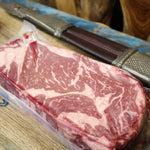
Chapter 10: Shorthorn
In the verdant landscapes of Britain, where rolling hills and lush pastures define the scenery, Shorthorn cattle graze—a breed that epitomizes versatility and the art of dual-purpose functionality. With their distinctive red, white, or roan coats and balanced conformation, Shorthorns have made an indelible mark in British agriculture and beyond.
British Origins and Distinctive Coat Colors:
The Shorthorn breed has its roots in England, where it evolved during the late 18th century through a combination of local cattle and select imports. What sets Shorthorns apart is not just their history but the variety in coat colors. While many Shorthorns exhibit the classic red and white pattern, they can also appear as solid red or white, as well as roan (a mix of red and white). This diverse palette adds not only aesthetic charm but also genetic flexibility to the breed.
Versatility in Purpose:
Shorthorn cattle are celebrated for their dual-purpose qualities, excelling in both beef and milk production. This versatility has been a hallmark of the breed's success over the centuries. Shorthorns have proven their ability to provide high-quality beef while simultaneously producing abundant and nutritious milk.
In beef production, Shorthorns are known for their well-marbled meat and efficient feed conversion. The breed's ability to produce quality beef has made it a preferred choice for those seeking a balance between meat quantity and quality.
As dairy cows, Shorthorns have a reputation for producing milk with a balanced composition, rich in butterfat and protein. While they may not match the extreme milk production of specialized dairy breeds, Shorthorns contribute to a sustainable and dual-purpose approach in dairy farming.
Adaptability and Global Influence:
Shorthorn cattle's adaptability has contributed to their global influence. From the green pastures of Britain, Shorthorns have traveled across continents, finding homes in various climates and agricultural systems. Their adaptability to different environments makes them versatile assets for farmers seeking resilient genetics.
The influence of Shorthorn genetics extends to crossbreeding programs, where their dual-purpose characteristics contribute to improving overall herd performance. Shorthorn genetics are often incorporated into both beef and dairy herds to enhance traits such as fertility, calving ease, and milk quality.
Culinary Excellence and Heritage:
Shorthorn beef, with its fine marbling and rich flavor, has earned a place in culinary circles. The breed's heritage is not just in the fields but also on the dinner table, where Shorthorn beef is appreciated for its tenderness and distinctive taste. The balance of lean meat and marbling makes Shorthorn beef a versatile choice for a variety of culinary creations.
Beyond the plate, Shorthorns embody a heritage deeply rooted in British agriculture. Their contribution to both beef and dairy production reflects a commitment to sustainability and efficiency—an ethos that aligns with the demands of modern farming.
Conclusion: Shorthorn—The Dual-Purpose Dynamo:
As Shorthorn cattle graze on the emerald pastures of Britain and beyond, they stand as dual-purpose dynamos, embodying the versatility that has defined their breed. From the rich history of British agriculture to the global stage, Shorthorns continue to be ambassadors of balance, contributing to both the beef and dairy sectors. Their story is not just one of adaptability but of a breed that has seamlessly blended tradition with modern demands, leaving an enduring legacy in the tapestry of agricultural diversity.



